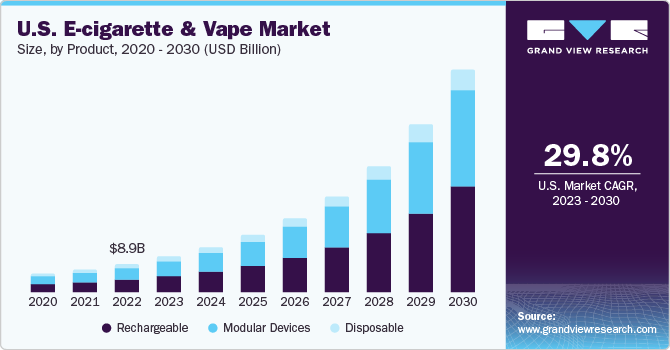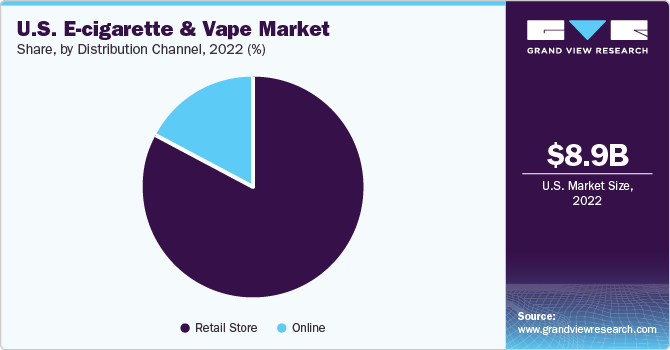- Home
- »
- Next Generation Technologies
- »
-
U.S. E-cigarette & Vape Market Size And Share Report, 2030GVR Report cover
![U.S. E-cigarette & Vape Market Size, Share & Trends Report]()
U.S. E-cigarette & Vape Market Size, Share & Trends Analysis Report By Product (Disposable, Rechargeable), By Distribution Channel (Online, Retail Store), And Segment Forecasts, 2023 - 2030
- Report ID: GVR-2-68038-945-6
- Number of Report Pages: 70
- Format: PDF, Horizon Databook
- Historical Range: 2018 - 2021
- Forecast Period: 2023 - 2030
- Industry: Technology
U.S. E-cigarette & Vape Market Trends
The U.S. e-cigarette & vape market size was valued at USD 8.98 billion in 2022. It is expected to expand at a compound annual growth rate (CAGR) of 29.8% from 2023 to 2030. The market growth can be attributed to the increasing awareness of safer tobacco alternatives. Electronic cigarettes and vape mods, an alternative to tobacco products, have been gaining popularity. These sophisticated mechanical devices are designed to deliver the same addictive nicotine in tobacco cigarettes without the harmful effects of tobacco smoke. Users are focusing on adopting personalized vaporizers. These vaporizers provide the best user experience in vaping and effectively cater to the needs of the regular and most active vapers. Health concerns related to smoking have considerably increased in the past few years as individual organizations and governments treat this issue with high priority. Increasing awareness about health concerns is anticipated to propel the market growth over the forecast period.

The usage of e-cigarettes and vape mods is rapidly increasing because these devices do not include tobacco. Most of the U.S. population considers these devices a gateway to quitting smoking. Some of the population is shifting to an e-cigarette and vape mod as an alternative to smoking. Furthermore, these products are being offered in non-nicotine as well as nicotine forms, due to which a substantial portion of the population considers these devices to be a better alternative.
Numerous studies conducted by medical association state that e-cigarettes and vape mods are safer than traditional cigarettes. Also, the market growth is characterized by the increasing awareness among the young population. Moreover, vendors' focus on customizing options and continuous development of new products is expected to fuel the market growth over the forecast period. Furthermore, the cost-efficiency of these devices has also increased customer acceptance.
Stringent government regulations in the U.S. hampered the market growth. The U.S. Centers for Disease Control and Prevention and the U.S. Food and Drug Administration are working continuously to investigate the distressing incidents of severe breathing illness associated with vaping products. Vendors in the market temporarily stopped production due to the COVID-19 lockdown, and logistics providers halted goods transportation within and across the borders.
Product Insights
The rechargeable segment led the market and accounted for a 45.8% share of the U.S. revenue in 2022. The lower costs of rechargeable cigarettes are expected to drive the adoption of these devices among users. A rechargeable cigarette is a battery-powered vaping device which can be reused and refilled. These devices also have interchangeable cartridges so that users can try various flavors.
The modular devices segment is anticipated to expand at the fastest CAGR of 31.2% over the forecast period. Users are widely adopting these devices as these devices have larger batteries and hold more e-liquid. The features of these devices include voltage control, wattage control, and temperature control. Furthermore, this device also includes a battery monitoring feature, which gives users a better view of the remaining battery power.
Distribution Channel Insights
The retail store segment dominated the e-cigarette & vape market and accounted for more than 82.9% market share in 2022. Retail stores allow customers to try out numerous e-liquid flavors and check the various kinds of vaporizers available in the market. Users choose to visit these retail stores to make these purchases. As a result, the popularity of retail stores is increasing across several states of the U.S.

The online segment is expected to expand at the fastest with a CAGR of 35.0% over the forecast period. Numerous vendors in the U.S. are opting for online channels as their preferred distribution channel over retail stores due to stringent regulations about the sale and distribution of e-cigarettes. Several social media platforms are being used to sell and advertise such electronic smoking devices.
Key Companies & Market Share Insights
Market players are focusing on inorganic growth strategies, such as acquisitions & mergers, and collaborations to augment their market share. For instance, in July 2023, Japan Tobacco Inc. announced the launch of a new brand of heated tobacco products called "with”. The new brand was accompanied by a new device called "with 2" that heats tobacco capsules without burning them.
Key U.S. E-cigarette & Vape Companies:
- Reynolds American Inc.
- Imperial Brands
- Altria Group, Inc.
- Japan Tobacco Inc.
- Philip Morris International
- International Vapor Group
- British American Tobacco
- NicQuid
- Shenzhen IVPS Technology Co., Ltd.
- Shenzhen KangerTech Technology Co., Ltd.
Recent Developments
-
In March 2023, Altria, a cigarette firm in the U.S., announced a definitive agreement to acquire NJOY Holdings, Inc. The acquisition gives Altria complete global control of NJOY's e-vapor product line, including NJOY ACE, the only FDA-approved pod-based e-vapor device.
-
In February 2023, Imperial Brands, a British multinational tobacco business, launched the all-new Pulze 2.0, an improved Pulze heated tobacco gadget. With this launch, the company aimed to make more attractive and potentially less harmful products. With a tiny all-in-one design and 25 or more sessions on a single charge, Pulze 2.0 redefines convenience and it is also compatible with Imperial's iD sticks.
U.S. E-cigarette & Vape Market Report Scope
Report Attribute
Details
Market size value in 2023
USD 11.19 billion
Revenue forecast in 2030
USD 69.53 billion
Growth rate
CAGR of 29.8% from 2023 to 2030
Base year for estimation
2022
Historical data
2018 - 2021
Forecast period
2023 - 2030
Report updated
November 2023
Quantitative units
Revenue in USD million/billion and CAGR from 2023 to 2030
Report coverage
Revenue forecast, company ranking, competitive landscape, growth factors, and trends
Segments covered
Product, distribution channel
Country scope
U.S.
Key companies profiled
Reynolds American Inc.; Imperial Brands; Altria Group, Inc.; Japan Tobacco Inc.; Philip Morris International; International Vapor Group; British American Tobacco; NicQuid; Shenzhen IVPS Technology Co., Ltd.; Shenzhen KangerTech Technology Co., Ltd.
Customization scope
Free report customization (equivalent up to 8 analyst’s working days) with purchase. Addition or alteration to country, regional & segment scope
Pricing and purchase options
Avail customized purchase options to meet your exact research needs. Explore purchase options
U.S. E-cigarette & Vape Market Report Segmentation
This report forecasts revenue growth at global, regional, and country levels and provides an analysis of the latest industry trends in each of the sub-segments from 2018 to 2030. For this study, Grand View Research has segmented the U.S. e-cigarette & vape market report based on product and distribution channels:
-
Product Outlook (Revenue, USD Million, 2018 - 2030)
-
Disposable
-
Rechargeable
-
Modular Devices
-
-
Distribution Channel Outlook (Revenue, USD Million, 2018 - 2030)
-
Online
-
Retail Store
-
Convenience Stores
-
Drug Stores
-
News Stands
-
Tobacconist
-
Specialty E-cigarette Stores
-
-
Frequently Asked Questions About This Report
b. The U.S. e-cigarette & vape market size was estimated at USD 8.98 billion in 2022 and is expected to reach USD 11.19 billion in 2023.
b. The U.S. e-cigarette & vape market is expected to grow at a compound annual growth rate of 29.8% from 2023 to 2030 to reach USD 69.53 billion by 2030.
b. The rechargeable segment dominated the U.S. e-cigarette & vape market with a share of 45.8% in 2022. This is attributable to the low costs of rechargeable e-cigarettes. Rechargeable product variants comprise an internal battery and can be considered ideal for prolonged usage.
b. Some key players operating in the U.S. e-cigarette & vape market include British American Tobacco; International Vapor Group; NicQuid; Altria Group, Inc.; R.J. Reynolds Vapor Company; Imperial Brands; Shenzhen KangerTech Technology Co., Ltd.; Japan Tobacco International; Philip Morris International Inc.; and Shenzhen IVPS Technology Co., Ltd.
b. Key factors that are driving the market growth include technological advances in e-cigarettes and growing awareness for safer tobacco alternatives.
Share this report with your colleague or friend.
![gvr icn]()
NEED A CUSTOM REPORT?
We can customize every report - free of charge - including purchasing stand-alone sections or country-level reports, as well as offer affordable discounts for start-ups & universities. Contact us now
![Certified Icon]()
We are GDPR and CCPA compliant! Your transaction & personal information is safe and secure. For more details, please read our privacy policy.
We are committed towards customer satisfaction, and quality service.
"The quality of research they have done for us has been excellent."





